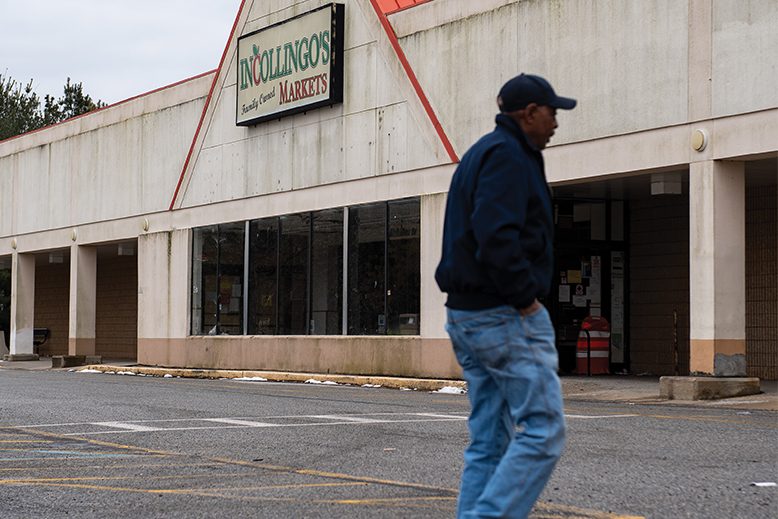
Jose Cruz parks his bicycle in front of the Dollar Tree that anchors an otherwise spartan shopping plaza on East Broadway in the historic South Jersey city of Salem. Inside, the 56-year-old fills his plastic shopping basket with a pint of whole milk, a quart of prune juice, a six-pack of orange drink, processed pork roll and salami, frozen tater tots, canned beans and rice. That will have to do for this shopping trip. Like many who live in Salem County, Cruz has scant choices for fulfilling his grocery needs.
Next door, the dusty windows and silent cash registers of Incollingo’s Family Owned Market, which closed in September 2017, reminds the city of Salem’s 4,931 residents on a daily basis that their food options are severely limited.
“It’s very difficult,” says Cruz, who lost both his factory job and his driver’s license in the last six months. “When that store was open, I could buy everything I needed: pork chops, chicken, vegetables. Now if I want those things, I have to take the bus.”
When Incollingo’s closed, the Walmart in Pennsville, four miles away, became the closest supermarket, thrusting Salem onto New Jersey’s long list of food deserts. So far, no grocer has stepped forward to fill the empty store located just outside the historic downtown of this county seat, where the median household income is $26,419. But that might change with the state Assembly’s recent passage of a raft of bills related to food insecurity and access, one of which provides incentives to grocery-store owners to open in places like Salem.
“Despite being a wealthy state, we have too many people who live below the poverty line and really struggle to have access to healthy foods,” says Assembly Speaker Craig Coughlin (D-South Amboy), sponsor of the Food Desert Elimination Act, the key piece of legislation. “I think this will go a long way toward alleviating that situation.” At deadline, the bills were awaiting Senate action.

A look inside the abandoned Incollingos’s Family Owned Market in Salem. Photo by Kriston Jae Bethel
The U.S. Department of Agriculture defines food deserts as low-income areas where more than a third of the population does not have easy access to fresh food. For urban settings, that means no full-service grocery store within one mile; for rural areas, it is beyond 10 miles, says the USDA, which has identified 134 food deserts in New Jersey.
The overall number of food-insecure individuals in New Jersey is close to 10 percent of the state’s population. A 2018 study by the Reinvestment Fund, a policy and investment organization focusing on low-income communities, found that as of 2016, 879,188 New Jersey residents were living in limited supermarket-access areas. And nearly 1.1 million in New Jersey are considered food insecure, many relying on food-assistance programs. In 2017, 730,000 state residents participated in SNAP, the federal food stamp program. Another 134,000 received benefits from WIC, the federal nutrition program for women, infants and children, according to Adele LaTourette, director of Hunger Free NJ.
For many in these programs, food procurement is not easy, says LaTourette. Beneficiaries of the WIC program, for example, must shop for specifically defined nutritional items. “It’s a challenge and a half to do that at a bodega,” says LaTourette, “but it’s also a challenge and a half to schlep your children on a bus to a supermarket to buy those groceries and then return on the bus with your bags and kids.” LaTourette sees the new legislation as a first step in improving the shopping experience.
The Food Desert Elimination bill offers store owners four years of property tax credits for being the first to open in a designated food desert. (The New Jersey Economic Development Authority would be tasked with listing 75 food deserts throughout the state.) A second incentive gives those who plant the first flag the opportunity to buy a special liquor-license permit to sell alcohol in the new store. This element proved controversial, with some questioning the wisdom of offering alcohol in stores meant to provide healthy food options to populations that may already face substance-abuse challenges. Coughlin dismisses this line of thinking, noting, “It’s not going to change people’s drinking habits. People who drink now are going to continue to drink. It’s the healthy food access that’s important. And the liquor license helps the stores be sustainable.”

In the food desert of Williamstown, in Gloucester County, residents line up with wheel barrows to cart groceries from the Hope Mobile, a food pantry on wheels. Photo by Kriston Jae Bethel
Remaining sustainable in these tenuous communities is the greatest challenge. Just ask Jason Ravitz, who has struggled mightily since opening a PriceRite store on Mt. Ephraim Avenue in Camden with his two brothers in October 2014. Ravitz’s store replaced a shuttered Pathmark, becoming the first full-service supermarket to open in this city in 45 years.
To help cover start-up and staff-training costs, Ravitz Family Markets secured a $100,000 grant from the state Economic Development Authority in combination with the Reinvestment Fund and TD Bank. (The six-year grant is soon to expire.) The grant has helped, Ravitz says, but not enough to offset the $500,000 loss the store has endured each year. “We’ve been discussing exiting the market,” says the 47-year-old grocer, whose family also operates five ShopRites in Burlington and Camden counties.
“I love that store, and I love my employees there. But we’re not doing well in terms of sales volume. We need to at least break even,” says Ravitz. He says he has gone to local officials for help, “but no one’s listening.”
Among the challenges Ravitz cites are an ever-changing food stamp program (about 50 percent of his sales are paid for with SNAP benefits), transportation challenges that prevent North Camden residents from coming to his PriceRite location, and the inability to attract shoppers from neighboring suburban towns like Collingswood or Haddon Township, despite what he calls an “aggressive marketing campaign.”
“Despite being a wealthy state, we have too many people who live below the poverty line and really struggle to have access to healthy foods”—Assembly Speaker Craig Coughlin
Because his store already exists in this former food desert, Ravitz would not qualify for the tax credits offered by the new legislation. Commenting on the legislation, the New Jersey Food Council recommended allowing existing stores in food deserts to benefit from the incentives as well. But the bill contains no such provision.
“If retailers are already operating in these distressed areas and they’re struggling right now, why not offer them these tax incentives and liquor licenses to help make it work?” asks Mary Ellen Peppard, vice president of the NJ Food Council, which represents 1,400 food retailers and distributors throughout the state. While appreciating the Legislature’s efforts to provide retailers with new opportunities, Peppard noted that the tax incentive, while helpful, may not be enough.
“There are a lot of challenges when trying to open in these low-income areas,” she says. “They have to make sure they have SNAP and WIC in place. Do they have a sufficient volume of customers? A means of transportation? Appropriate parking? Then there are education issues, so they’ll need dieticians in the stores. Our members would love to be in every food desert in the state, but it’s just not possible.”
Peppard’s skepticism is echoed by others working on food issues throughout the state who feel that tapping into the existing food-distribution system in these underserved communities is a better way to go. Providing healthier, fresh foods to their food-pantry clients has become a top priority for both the Food Bank of South Jersey and MEND Hunger Relief Network over the last few years.
A bright-green school bus splattered with paintings of fruits and vegetables has been pulling up outside many of Essex County’s 19 food-pantry sites that are part of the MEND network. Dubbed the Green Bean, the school bus was donated to MEND in 2017 and has been on the road since May 2018, getting fresh food into the communities it serves. When clients come to pick up their monthly allotment of pasta, peanut butter, tuna, cereal, and canned fruits and vegetables, they might also receive a box filled with fresh apples, cauliflower, zucchini, onions, potatoes, fresh chicken, or whatever else gets donated or grown by local community gardens and farms.
“I had a resident from West Orange call me in tears saying, ‘I can’t believe someone brought me such nice food,’” recalls Robin Peacock, MEND’s executive director. “It’s one way we can make a little difference on this issue.”
Supporting more than 150 food pantries in Burlington, Camden, Gloucester and Salem counties, the Food Bank of South Jersey provides 12.5 million pounds of food to about 200,000 people annually. But while many of the pantry sites are well established, it has been more difficult reaching into the food deserts, 21 of which have been identified in the umbrella organization’s coverage area. Enter the Hope Mobile. In operation since 2010, the tractor-trailer truck arrives before dawn, dropping off thousands of pounds of food for those living in urban and more remote food-desert areas.

Hope Mobile volunteer Reda Ouda also stocks up on food from the service, which started in 2010. Photo by Kriston Jae Bethel
“We provide the balance,” says Lavinia Awosanya, FBSJ’s director of strategic partnerships. “In the urban areas, they lack produce, and in the rural areas, they lack staples, so we make sure we’re filling in with what is needed in each community.”
In New Brunswick, Cara Cuite, an assistant extension specialist at Rutgers Co-Operative Extension, says local stores, commonly known as corner stores, are where many of the city’s residents shop.
“There are good reasons people shop at the corner store,” says Cuite. “There’s a level of trust. They know you there; they might know your kids. If you don’t speak English, they might speak your language. And it’s convenient. So the big question is, how do you get these stores to have more fresh food for sale?”
The answer has been the Healthy Corner Store Initiative, a local program sponsored in part by Rutgers Co-Operative Extension and the New Brunswick Food Alliance. The program offers displays, recipes and educational materials to encourage shopkeepers to sell more fresh foods and shoppers to purchase these items.
Educating shoppers is also a primary concern of Biancha Jackson, the in-store nutritionist at a ShopRite in Newark’s University Heights neighborhood. Shoppers (or even those who purchase nothing) can take advantage of Jackson’s free dietary counseling as part of ShopRite’s chain-wide on-site dietician program.
Jackson says 9 out of 10 of her clients are food insecure, many are obese, and most have type 2 diabetes, hypertension or both. She sees some clients on a regular basis; others might stop by for advice on how to stretch their SNAP benefits or to learn the difference in nutritional benefits between name-brand vs. store-brand goods (none). For some, she has to break the news that a strawberry Starburst doesn’t cover their fruit intake for the day.
“A lot of people think, Wow, how could I not know this? But it’s because they didn’t get adequate nutritional education growing up,” says Jackson. “A program like this is great because you’re getting people where they’re shopping, before they’ve even purchased anything. And that’s where it all starts.”
